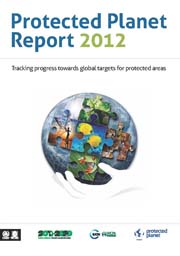Protected Planet Report 2012

Photo: UNEP WCMC
Protected areas remain one of the cornerstones for promoting biodiversity, ecosystem services and human well-being. Today protected areas cover 12.7% of the world’s terrestrial area and 1.6% of the global ocean area. They store 15% of the global terrestrial carbon stock, assist in reducing deforestation, habitat and species loss, and support the livelihoods of over one billion people.
At the United Nations Conference on Sustainable Development (Rio+20) world leaders reaffirmed the value of biological diversity, its critical role in maintaining ecosystem services and the urgency to implement actions to halt and reverse the loss of biodiversity.
The Protected Planet Report is a new initiative that tracks global progress towards Target 11 of the Convention on Biological Diversity’s (CBD) Aichi Biodiversity Targets. Achieving this ambitious target, which calls for at least 17% of the world’s terrestrial areas and 10% of marine areas to be equitably managed and conserved by 2020, will require strong and effective partnerships: this report is an excellent example.
It has been compiled by the UNEP World Conservation Monitoring Centre, IUCN World Commission on Protected Areas and a wide range of organisations that build on the work of the CBD-mandated Biodiversity Indicators Partnership. Several of these indicators also regularly contribute to the Global Environment Outlook and Global Biodiversity Outlook assessments, as well as the Millennium Development Goals reports – they have a role to play in the development of Sustainable Development Goals post 2015 too.
The Protected Planet Report 2012 underlines the successes of countries, communities and nongovernmental organisations with respect to protected areas – since 1990, for example, protected areas have increased in number by 58% and in their extent by 48%. However, many protected areas face management, governance and financial challenges and half of the world’s most important sites for biodiversity are still unprotected.
On a planet of seven billion people, rising to over nine billion by 2050, the need for robust, dynamic and well-managed protected areas is even more crucial today than it was in past decades and centuries. This report provides not only the facts and figures required by governments to make informed decisions and choices, but also illuminates some of the pathways towards achieving a sustainable 21st century – one that grows economies and generates jobs but keeps humanity’s footprint within ecological boundaries.
